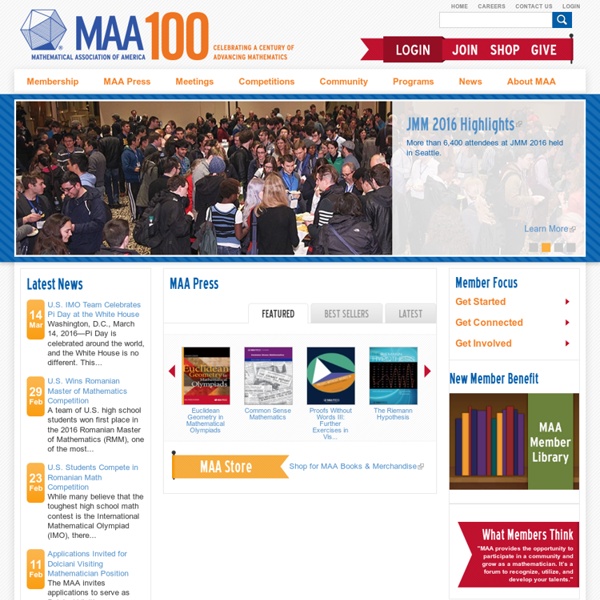



Difference Between a Percentage and a Rate (as explained by medical field) Often we hear the question, "What is the difference between a percentage and a rate?" They are both calculated using a numerator and a denominator. However, the relationship between the numerator and denominator makes the difference. Percentages Indicators which use percentage are the most commonly used indicator type in healthcare. The future of high school math education (article) Students at International Mathematical Olympiad Amsterdam 2011. (VALERIE KUYPERS/AFP/Getty Images) A few weeks ago a group of senior mathematicians, teachers, statisticians, and curriculum developers met in Boston to discuss the future of high school mathematics, revisiting issues addressed by a 2008 conference organized by the Center for Mathematics Education at the University of Maryland. This time, the Common Core State Standards was front and center of the discussion.
Karl's Calculus Tutor - Putting the Squeeze on a Limit An Arabian Night "Long ago a merchant's son set off for Cairo to trade for goods at the bazaar. When after a week he did not return, his sister grew worried, and when after two weeks he did not return, she became distraught and could not sleep. So on the fifteenth day she sought advice from the old hermit who lived far outside of town.
Similar Triangles Applications Image Source: A powerful Zoom lens for a 35mm camera can be very expensive, because it actually contains a number of highly precise glass lenses, which need to be moved by a tiny motor into very exact positions as the camera auto focuses. The Geometry and Mathematics of these lenses is very involved, and they cannot be simply mass produced and tested by computer robots. Lots of effort required to manufacture these lenses results in their very high price tags. Here is a diagram showing how the zoom lens internal arrangement changes as we zoom from 18mmm wide angle to 200mm fully zoomed in: Image Source: What's wrong with math education in the U.S.? (article) Photo by Creatas/Thinkstock This question originally appeared on Quora. Answer by Alon Amit, Ph.D. in mathematics, math circler: This is (obviously, I hope) a complex and controversial question. It is also geographically diverse: Whatever problems exist in math education in the U.S. are very different from those in India, Mexico, or Mongolia. I'll focus on the U.S.
"Design Variables of Attraction in Quest-Based Learning" by Charles Christopher Haskell Charles Christopher Haskell , Boise State University Abstract Critics of the American education system point to student boredom, lack of personalized and relevant instruction, and a deficit of 21st century skills as challenges to producing productive citizens of a modern, digital society (Barab et al., 2009; Eccles & Wingfield, 2002; Ketelhut, 2007; U.S. Department of Education Office of Educational Technology, 2010). Digital learning, including game-based approaches, offers opportunities to bring about meaningful, engaging, individualized learning (Barab & Dede, 2007; Gee, 2005; Squire, 2003). Aspect Ratios in Photography This article is written by Andrew S. Gibson, the author of Square. Today I’d like to draw your attention to an area of composition that you might not have given much thought to: aspect ratio. Aspect ratio is the term used to describe the dimensions of an image by comparing the width to the height and expressing it in ratio form.
Math Baseball Advertisement One Player Pick the kind of game and level you wish to play. Some Mathematical GIFs Here are some GIFs I have collected over internet that explain mathematical ideas. The following GIF explain what is meant by tangent/parallel lines and asymptotes. The following GIF explains how to construct a regular heptagon using straight edge and compass. The Pre-Algebra Tutor: Volume 1 - 5 Hour Course Learn with step-by-step worked problems. Prepare for exams, homework, and quizzes. This Course is Available for Download Download Price: $23.00 Disk 1Sect 1 - Real NumbersSect 2 - The Number Line [View Sample Lesson]Sect 3 - Greater Than, Less Than, Equal ToSect 4 - Absolute Value and Adding Integers [View Sample Lesson]Sect 5 - Subtracting Integers Disk 2Sect 6 - Multiplying IntegersSect 7 - Dividing IntegersSect 8 - Powers and ExponentsSect 9 - Order of Operations [View Sample Lesson]
Stats: Binomial Probabilities Binomial Experiment A binomial experiment is an experiment which satisfies these four conditions A fixed number of trials Each trial is independent of the others There are only two outcomes The probability of each outcome remains constant from trial to trial. NROC // National Repository of Online Courses This curriculum integrates multiple modes of learning to open the door to mathematical reasoning and critical thinking for a broad range of learners. The learning object architecture allows institutions, instructors and students to adapt the content to different program and learner requirements. This program includes nineteen units comprised of 57 lessons and 103 topics.
The Unexpected Math behind Van Gogh's "Starry Night" A few lesson plans exist for teaching visual arts and self-similarity (objects that have the same pattern) that could be used after showing this lesson. Shodor has some free lesson plans for students in grades 4 through 8. High school students can learn recursion algorithms to create the Koch curve using Scratch for free. Educational technologist Dylan Ryder has also written about creating fractals.
Fields Institute - Math Circles NEWS 2014: Math Circles Instructors wanted! (Apply here) Math Circles at the Fields Institute is looking for new volunteers to teach bright high school students interesting topics in mathematics.